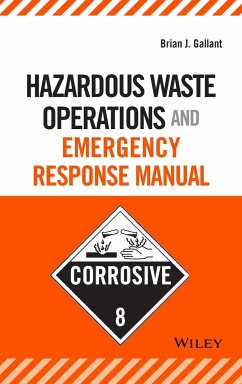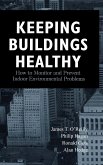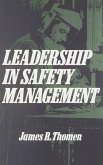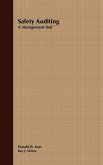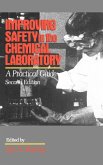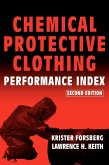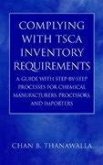Brian J Gallant
Hazardous Waste Operations and Emergency Response Manual
Brian J Gallant
Hazardous Waste Operations and Emergency Response Manual
- Gebundenes Buch
- Merkliste
- Auf die Merkliste
- Bewerten Bewerten
- Teilen
- Produkt teilen
- Produkterinnerung
- Produkterinnerung
THE DEFINITIVE TRAINING RESOURCE FOR HAZMAT AND EMERGENCY RESPONSE PERSONNEL Field technicians and emergency response personnel are often faced with the dangers of flammable, combustible, and chemically unstable materials. Although there are numerous procedures set forth by regulatory agencies like the Occupational Safety and Health Administration (OSHA), the Environmental Protection Agency (EPA), and the National Institute for Occupational Safety and Health (NIOSH) for effectively and safely dealing with such environmental hazards, up until now there has been no single resource for training…mehr
Andere Kunden interessierten sich auch für
![Keeping Buildings Healthy Keeping Buildings Healthy]() James T O'ReillyKeeping Buildings Healthy250,99 €
James T O'ReillyKeeping Buildings Healthy250,99 €![Leadership in Safety Management Leadership in Safety Management]() James R ThomenLeadership in Safety Management298,99 €
James R ThomenLeadership in Safety Management298,99 €![Safety Auditing Safety Auditing]() Donald W KaseSafety Auditing245,99 €
Donald W KaseSafety Auditing245,99 €![Improving Safety in the Chemical Laboratory Improving Safety in the Chemical Laboratory]() Improving Safety in the Chemical Laboratory323,99 €
Improving Safety in the Chemical Laboratory323,99 €![Chemical Protective Clothing Performance Index Chemical Protective Clothing Performance Index]() Krister ForsbergChemical Protective Clothing Performance Index347,99 €
Krister ForsbergChemical Protective Clothing Performance Index347,99 €![Innovations in Safety Management Innovations in Safety Management]() Fred A ManueleInnovations in Safety Management211,99 €
Fred A ManueleInnovations in Safety Management211,99 €![Complying with Tsca Inventory Requirements Complying with Tsca Inventory Requirements]() Chan B ThanawallaComplying with Tsca Inventory Requirements168,99 €
Chan B ThanawallaComplying with Tsca Inventory Requirements168,99 €-
-
-
THE DEFINITIVE TRAINING RESOURCE FOR HAZMAT AND EMERGENCY RESPONSE PERSONNEL Field technicians and emergency response personnel are often faced with the dangers of flammable, combustible, and chemically unstable materials. Although there are numerous procedures set forth by regulatory agencies like the Occupational Safety and Health Administration (OSHA), the Environmental Protection Agency (EPA), and the National Institute for Occupational Safety and Health (NIOSH) for effectively and safely dealing with such environmental hazards, up until now there has been no single resource for training in this area. Based on the author's twenty-plus years of field experience, Hazardous Waste Operations and Emergency Response Manual is a comprehensive text that covers the complete curriculum requirements set forth by OSHA and HAZWOPER. Highly accessible and broad in focus, the book is equally useful as a technical resource for training, a hands-on reference for field operations, and a textbook for environmental courses in a variety of areas. Coverage includes: * Methods recommended by professional societies and regulatory agencies including the National Fire Protection Association, OSHA, EPA, and NIOSH * Practical examples and assignments in each chapter to supplement the text and enhance usefulness to students
Hinweis: Dieser Artikel kann nur an eine deutsche Lieferadresse ausgeliefert werden.
Hinweis: Dieser Artikel kann nur an eine deutsche Lieferadresse ausgeliefert werden.
Produktdetails
- Produktdetails
- Verlag: Wiley
- Seitenzahl: 344
- Erscheinungstermin: 1. Februar 2006
- Englisch
- Abmessung: 240mm x 161mm x 23mm
- Gewicht: 677g
- ISBN-13: 9780471684008
- ISBN-10: 0471684007
- Artikelnr.: 22063637
- Herstellerkennzeichnung
- Produktsicherheitsverantwortliche/r
- Europaallee 1
- 36244 Bad Hersfeld
- gpsr@libri.de
- Verlag: Wiley
- Seitenzahl: 344
- Erscheinungstermin: 1. Februar 2006
- Englisch
- Abmessung: 240mm x 161mm x 23mm
- Gewicht: 677g
- ISBN-13: 9780471684008
- ISBN-10: 0471684007
- Artikelnr.: 22063637
- Herstellerkennzeichnung
- Produktsicherheitsverantwortliche/r
- Europaallee 1
- 36244 Bad Hersfeld
- gpsr@libri.de
BRIAN J. GALLANT is the Vice President of Contingency Management Associates, where he is responsible for marketing, delivering, and coordination of field services. With more than twenty years of experience as an environmental and safety manager and consultant, he is a member of the National Association of Fire Investigators, the American Society of Safety Engineers, and the International Association of Firefighters, and is a Certified Hazardous Materials Manager.
1 Regulations, Agencies, and Resources 1
Introduction-History of Employee Health and Safety Regulations 1
Regulations 2
The Environmental Protection Agency 2
Hazardous Waste Numbers 3
EPA Identification Numbers 4
Clean Water Act 4
Clean Air Act 5
Resource Conservation and Recovery Act (RCRA) 5
Toxic Substance Control Act 6
Comprehensive Environmental Response Compensation and Liability Act
(CERCLA) 7
Superfund Amendment and Reauthorization Act (SARA) 7
Department of Labor-Occupational Safety and Health Administration 8
National Institute for Occupational Safety and Health (NIOSH) 9
Department of Transportation (DOT) 9
National Fire Protection Association (NFPA) 10
NFPA 704 Labeling 10
Hazard Communication Standard 12
Hazardous Waste Operations and Emergency Response (HAZWOPER) 13
Hazwoper Training 13
Incident Command System (ICS) 15
Resources 16
Materia] Safety Data Sheets (MSDS) 16
NIOSII Pocket Guide to Chemical Hazards 19
Emergency Response Guidebook 19
Summary 20
2 Hazard Classification 21
Chemical Exposure 24
Explosion and Fire 27
Oxygen Deficiency 28
Ionizing Radiation 28
Biological Hazards 29
General Safety Hazards 29
Electrical Hazards 31
Heat Stress 32
Cold Exposure 32
Noise 33
Poisonous Snakes Insects and Plants 33
Weather 34
Heavy Equipment 34
Tools 37
Definition of Hazardous Materials vs. Hazardous Waste 38
Classification of Hazardous Materials 40
Physical Properties of Hazardous Materials 41
Vapor Density and Specific Gravity 41
Flammability 43
Explosive Limits 43 Hash Point 43
Hammable Solids 44
Firefighting and Fire Prevention 44
Portable Fire Extinguishers 45
Toxic Products of Combustion 47
Corrosives 47
Acids 47
Alkalis 48
Reactivity of Some Common Elements 48
Water-Reactive Materials 48
Oxidizing Materials 49
Boiling Liquid Expanding Vapor Explosion (BLEVE) 49
Flammable and Combustible Liquid 51
Summary 53
3 Site Safety Plan 55
The Plan 56
Emergencies 57
Incident Characterization 57
Remedial Actions 58
Safety Plan Development 58
Routine Operations 59
Describe the Known Hazards and Risks 59
List Key Personnel and Alternates 60
Designate Levels of Protection to be Worn 60
Delineate Work Areas 60
List Control Procedures 60
Establish Decontamination Procedures 62
Address Requirements for an Environmental Surveillance Program 62
Specify Any Routine and/or Special Training Required 63
Establish Procedures for Weather-Related Problems 63
On Site Emergencies 65
Establish Site Emergency Procedures 65
Address Emergency Medical Care 66
Implementation of the Site Safety Plan 68
Typical Safety Plan Outline 72
Responsibilities 74
Client 74
Engineering Firm 75
Site Contractors 75
Consulting Firm / Site Safety Officer (SSO) 75
Summary 76
4 Site Characterization 77
Offsite Characterization 78
Interview/Records Research 79
Perimeter Investigation 81
Protection of Site Entry Workforce 83
Onsite Survey 84
Continuing the Survey 86
Information Documentation 90
Hazard Assessment 93
Threshold Limit Values 93
Permissible Exposure Limit 95
Recommended Exposure Limit 95
IDLH Concentrations 95
Potential Skin Absorption and Irritation 96
Potential Eye Irritation 96
Flammable and Explosive Range 96
Monitoring 97
Summary 100
5 Site Control 101
Site Map 102
Site Preparation 103
Site Preparation Tasks 104
Site Work Zones 105
Exclusion or Hot Zone 108
Contamination Reduction or Warm Zone 109
Support Zone or Cold Zone 111
Buddy System 112
Enforce Decontamination Procedures 115
Security Measures 116
Communication Networks 118
Internal Communications 118
Safety Meetings 119
External Communications 119
Summary 120
6 Toxicology and Medical Monitoring 121
Toxicity vs. Hazard 122
Toxicity Tests 122
Dose-Response Relationship 123
Measurement of Response 123
Dose-Response Terms 123
Use of Dose-Response Relationship 124
Limitations of Dose-Response Data 126
Routes of Exposure 127
Gender Differences 127
Age 127
Synergism, Antagonism, and Potentiation 128
Genetics 128
Species Variation 129
Kinds of Toxicity 129
Types of Toxic Effects 129
Toxic Substances and Cancer-Causing Agents 130
Introduction to Medical Monitoring 131
Developing a Program 133
Pre-Employment Screening 138
Sample Pre-Employment Examination 140
Additional Medical Testing 142
Baseline Monitoring 142
Periodic Medical Examinations 142
Sample Periodic Medical Examination 143
Termination Examination 143
Emergency Treatment 144
Non-Emergency Treatment 147
Medical Records 147
Program Review and Summary 147
7 Air Monitoring 149
Monitoring Instruments 149
Direct-Reading Instruments 150
Laboratory Analysis 155
Site Monitoring 158
Monitoring for Dangerous Conditions 159
General On-Site Monitoring 159
Perimeter Monitoring 160
Periodic Monitoring 160
Personal Monitoring 160
Variables of Hazardous - Waste Site Exposure 161
Limitations and Advantages of Monitoring Equipment 161
Summary 162
8 Personal Protective Equipment 163
Introduction 163
Developing a Personal Protective Equipment Program 165
Equipment Use 165
Program Review and Evaluation 166
Selection of Protective Clothing 167
Examples of Protective Clothing 167
Selection of Chemical Protective Clothing (CPC) 169
Selection of Ensembles 179
Personal Protective Equipment Use 185
Training 186
Work Duration 189
Inspection 195
Storage 196
Heat Stress and Other Physiological Factors 196
Monitoring 197
Prevention 199
Cold Weather Operations 200
Other Factors 205
Physical Condition 206
Level of Acclimatization 206
Age 207
Sex 207
Weight 207
Maintenance 208
Summary 208
9 Decontamination Procedures 209
Introduction 209
General Procedures 210
Preplanning for Decontamination 210
Personal Protective Equipment 211
Types of Decontamination 213
Physical Removal 213
Chemical Removal 213
Equipment Needs 215
Proper Disposal 215
Personal Protection 218
Preliminary Concerns 218
Level of Protection 220
Work Function 220
Location of Contamination 221
Reasons for Leaving Site 221
Establishment of Procedures 221
Decontamination during Medical Emergencies 222
Physical Injury 222
Partial and Full Decontamination 222
Persistent Contamination 225
Summary 230
10 Respiratory Protection 231
Selection of Respiratory Equipment 231
Air-Purifying Respirators 235
Air-Line Respirators (ALRs) 239
Self-Contained Breathing Apparatus (SCBA) 241
ln-Use Monitoring 246
Storage 247
Inspection 247
Cleaning of Respirators 248
Summary 248
11 Engineering Controls 249
Buddy System 249
Site Security 251
Communications Systems 255
Handling Hazardous-Waste Containers 258
Planning 259
Packaged Laboratory Wastes 263
Bulging, Leaking, Open, Deteriorated, or Buried Drums 263
Sampling 266
Characterization 267
Staging 268
Bulking 269
Shipment 269
Vacuum Trucks 270
Elevated Tanks 271
Compressed Gas Cylinders 271
Ponds and Lagoons 272
Tanks and Vaults 273
Confined Spaces 274
Trenching and Excavation Safety 279
Summary 285
12 Site Emergencies 287
Planning 288
Personnel 289
Federal Response Organizations 294
Training 295
Emergency Recognition and Prevention 296
Communications 297
Internal Communications 297
External Communications 299
Site Mapping 299
Safe Distances and Refuges 300
Site Security and Control 301
Personal Locator Systems 301
Evacuation Routes and Procedures 302
Decontamination 303
Equipment 304
Medical Treatment and First Aid 305
Emergency Response Procedures 307
Size-Up 308
Rescue/Response Action 308
Follow-Up Procedures 310
Documentation 310
Emergency Response Plan 311
Summary 313
Glossary 315
Index 321
Introduction-History of Employee Health and Safety Regulations 1
Regulations 2
The Environmental Protection Agency 2
Hazardous Waste Numbers 3
EPA Identification Numbers 4
Clean Water Act 4
Clean Air Act 5
Resource Conservation and Recovery Act (RCRA) 5
Toxic Substance Control Act 6
Comprehensive Environmental Response Compensation and Liability Act
(CERCLA) 7
Superfund Amendment and Reauthorization Act (SARA) 7
Department of Labor-Occupational Safety and Health Administration 8
National Institute for Occupational Safety and Health (NIOSH) 9
Department of Transportation (DOT) 9
National Fire Protection Association (NFPA) 10
NFPA 704 Labeling 10
Hazard Communication Standard 12
Hazardous Waste Operations and Emergency Response (HAZWOPER) 13
Hazwoper Training 13
Incident Command System (ICS) 15
Resources 16
Materia] Safety Data Sheets (MSDS) 16
NIOSII Pocket Guide to Chemical Hazards 19
Emergency Response Guidebook 19
Summary 20
2 Hazard Classification 21
Chemical Exposure 24
Explosion and Fire 27
Oxygen Deficiency 28
Ionizing Radiation 28
Biological Hazards 29
General Safety Hazards 29
Electrical Hazards 31
Heat Stress 32
Cold Exposure 32
Noise 33
Poisonous Snakes Insects and Plants 33
Weather 34
Heavy Equipment 34
Tools 37
Definition of Hazardous Materials vs. Hazardous Waste 38
Classification of Hazardous Materials 40
Physical Properties of Hazardous Materials 41
Vapor Density and Specific Gravity 41
Flammability 43
Explosive Limits 43 Hash Point 43
Hammable Solids 44
Firefighting and Fire Prevention 44
Portable Fire Extinguishers 45
Toxic Products of Combustion 47
Corrosives 47
Acids 47
Alkalis 48
Reactivity of Some Common Elements 48
Water-Reactive Materials 48
Oxidizing Materials 49
Boiling Liquid Expanding Vapor Explosion (BLEVE) 49
Flammable and Combustible Liquid 51
Summary 53
3 Site Safety Plan 55
The Plan 56
Emergencies 57
Incident Characterization 57
Remedial Actions 58
Safety Plan Development 58
Routine Operations 59
Describe the Known Hazards and Risks 59
List Key Personnel and Alternates 60
Designate Levels of Protection to be Worn 60
Delineate Work Areas 60
List Control Procedures 60
Establish Decontamination Procedures 62
Address Requirements for an Environmental Surveillance Program 62
Specify Any Routine and/or Special Training Required 63
Establish Procedures for Weather-Related Problems 63
On Site Emergencies 65
Establish Site Emergency Procedures 65
Address Emergency Medical Care 66
Implementation of the Site Safety Plan 68
Typical Safety Plan Outline 72
Responsibilities 74
Client 74
Engineering Firm 75
Site Contractors 75
Consulting Firm / Site Safety Officer (SSO) 75
Summary 76
4 Site Characterization 77
Offsite Characterization 78
Interview/Records Research 79
Perimeter Investigation 81
Protection of Site Entry Workforce 83
Onsite Survey 84
Continuing the Survey 86
Information Documentation 90
Hazard Assessment 93
Threshold Limit Values 93
Permissible Exposure Limit 95
Recommended Exposure Limit 95
IDLH Concentrations 95
Potential Skin Absorption and Irritation 96
Potential Eye Irritation 96
Flammable and Explosive Range 96
Monitoring 97
Summary 100
5 Site Control 101
Site Map 102
Site Preparation 103
Site Preparation Tasks 104
Site Work Zones 105
Exclusion or Hot Zone 108
Contamination Reduction or Warm Zone 109
Support Zone or Cold Zone 111
Buddy System 112
Enforce Decontamination Procedures 115
Security Measures 116
Communication Networks 118
Internal Communications 118
Safety Meetings 119
External Communications 119
Summary 120
6 Toxicology and Medical Monitoring 121
Toxicity vs. Hazard 122
Toxicity Tests 122
Dose-Response Relationship 123
Measurement of Response 123
Dose-Response Terms 123
Use of Dose-Response Relationship 124
Limitations of Dose-Response Data 126
Routes of Exposure 127
Gender Differences 127
Age 127
Synergism, Antagonism, and Potentiation 128
Genetics 128
Species Variation 129
Kinds of Toxicity 129
Types of Toxic Effects 129
Toxic Substances and Cancer-Causing Agents 130
Introduction to Medical Monitoring 131
Developing a Program 133
Pre-Employment Screening 138
Sample Pre-Employment Examination 140
Additional Medical Testing 142
Baseline Monitoring 142
Periodic Medical Examinations 142
Sample Periodic Medical Examination 143
Termination Examination 143
Emergency Treatment 144
Non-Emergency Treatment 147
Medical Records 147
Program Review and Summary 147
7 Air Monitoring 149
Monitoring Instruments 149
Direct-Reading Instruments 150
Laboratory Analysis 155
Site Monitoring 158
Monitoring for Dangerous Conditions 159
General On-Site Monitoring 159
Perimeter Monitoring 160
Periodic Monitoring 160
Personal Monitoring 160
Variables of Hazardous - Waste Site Exposure 161
Limitations and Advantages of Monitoring Equipment 161
Summary 162
8 Personal Protective Equipment 163
Introduction 163
Developing a Personal Protective Equipment Program 165
Equipment Use 165
Program Review and Evaluation 166
Selection of Protective Clothing 167
Examples of Protective Clothing 167
Selection of Chemical Protective Clothing (CPC) 169
Selection of Ensembles 179
Personal Protective Equipment Use 185
Training 186
Work Duration 189
Inspection 195
Storage 196
Heat Stress and Other Physiological Factors 196
Monitoring 197
Prevention 199
Cold Weather Operations 200
Other Factors 205
Physical Condition 206
Level of Acclimatization 206
Age 207
Sex 207
Weight 207
Maintenance 208
Summary 208
9 Decontamination Procedures 209
Introduction 209
General Procedures 210
Preplanning for Decontamination 210
Personal Protective Equipment 211
Types of Decontamination 213
Physical Removal 213
Chemical Removal 213
Equipment Needs 215
Proper Disposal 215
Personal Protection 218
Preliminary Concerns 218
Level of Protection 220
Work Function 220
Location of Contamination 221
Reasons for Leaving Site 221
Establishment of Procedures 221
Decontamination during Medical Emergencies 222
Physical Injury 222
Partial and Full Decontamination 222
Persistent Contamination 225
Summary 230
10 Respiratory Protection 231
Selection of Respiratory Equipment 231
Air-Purifying Respirators 235
Air-Line Respirators (ALRs) 239
Self-Contained Breathing Apparatus (SCBA) 241
ln-Use Monitoring 246
Storage 247
Inspection 247
Cleaning of Respirators 248
Summary 248
11 Engineering Controls 249
Buddy System 249
Site Security 251
Communications Systems 255
Handling Hazardous-Waste Containers 258
Planning 259
Packaged Laboratory Wastes 263
Bulging, Leaking, Open, Deteriorated, or Buried Drums 263
Sampling 266
Characterization 267
Staging 268
Bulking 269
Shipment 269
Vacuum Trucks 270
Elevated Tanks 271
Compressed Gas Cylinders 271
Ponds and Lagoons 272
Tanks and Vaults 273
Confined Spaces 274
Trenching and Excavation Safety 279
Summary 285
12 Site Emergencies 287
Planning 288
Personnel 289
Federal Response Organizations 294
Training 295
Emergency Recognition and Prevention 296
Communications 297
Internal Communications 297
External Communications 299
Site Mapping 299
Safe Distances and Refuges 300
Site Security and Control 301
Personal Locator Systems 301
Evacuation Routes and Procedures 302
Decontamination 303
Equipment 304
Medical Treatment and First Aid 305
Emergency Response Procedures 307
Size-Up 308
Rescue/Response Action 308
Follow-Up Procedures 310
Documentation 310
Emergency Response Plan 311
Summary 313
Glossary 315
Index 321
1 Regulations, Agencies, and Resources 1
Introduction-History of Employee Health and Safety Regulations 1
Regulations 2
The Environmental Protection Agency 2
Hazardous Waste Numbers 3
EPA Identification Numbers 4
Clean Water Act 4
Clean Air Act 5
Resource Conservation and Recovery Act (RCRA) 5
Toxic Substance Control Act 6
Comprehensive Environmental Response Compensation and Liability Act
(CERCLA) 7
Superfund Amendment and Reauthorization Act (SARA) 7
Department of Labor-Occupational Safety and Health Administration 8
National Institute for Occupational Safety and Health (NIOSH) 9
Department of Transportation (DOT) 9
National Fire Protection Association (NFPA) 10
NFPA 704 Labeling 10
Hazard Communication Standard 12
Hazardous Waste Operations and Emergency Response (HAZWOPER) 13
Hazwoper Training 13
Incident Command System (ICS) 15
Resources 16
Materia] Safety Data Sheets (MSDS) 16
NIOSII Pocket Guide to Chemical Hazards 19
Emergency Response Guidebook 19
Summary 20
2 Hazard Classification 21
Chemical Exposure 24
Explosion and Fire 27
Oxygen Deficiency 28
Ionizing Radiation 28
Biological Hazards 29
General Safety Hazards 29
Electrical Hazards 31
Heat Stress 32
Cold Exposure 32
Noise 33
Poisonous Snakes Insects and Plants 33
Weather 34
Heavy Equipment 34
Tools 37
Definition of Hazardous Materials vs. Hazardous Waste 38
Classification of Hazardous Materials 40
Physical Properties of Hazardous Materials 41
Vapor Density and Specific Gravity 41
Flammability 43
Explosive Limits 43 Hash Point 43
Hammable Solids 44
Firefighting and Fire Prevention 44
Portable Fire Extinguishers 45
Toxic Products of Combustion 47
Corrosives 47
Acids 47
Alkalis 48
Reactivity of Some Common Elements 48
Water-Reactive Materials 48
Oxidizing Materials 49
Boiling Liquid Expanding Vapor Explosion (BLEVE) 49
Flammable and Combustible Liquid 51
Summary 53
3 Site Safety Plan 55
The Plan 56
Emergencies 57
Incident Characterization 57
Remedial Actions 58
Safety Plan Development 58
Routine Operations 59
Describe the Known Hazards and Risks 59
List Key Personnel and Alternates 60
Designate Levels of Protection to be Worn 60
Delineate Work Areas 60
List Control Procedures 60
Establish Decontamination Procedures 62
Address Requirements for an Environmental Surveillance Program 62
Specify Any Routine and/or Special Training Required 63
Establish Procedures for Weather-Related Problems 63
On Site Emergencies 65
Establish Site Emergency Procedures 65
Address Emergency Medical Care 66
Implementation of the Site Safety Plan 68
Typical Safety Plan Outline 72
Responsibilities 74
Client 74
Engineering Firm 75
Site Contractors 75
Consulting Firm / Site Safety Officer (SSO) 75
Summary 76
4 Site Characterization 77
Offsite Characterization 78
Interview/Records Research 79
Perimeter Investigation 81
Protection of Site Entry Workforce 83
Onsite Survey 84
Continuing the Survey 86
Information Documentation 90
Hazard Assessment 93
Threshold Limit Values 93
Permissible Exposure Limit 95
Recommended Exposure Limit 95
IDLH Concentrations 95
Potential Skin Absorption and Irritation 96
Potential Eye Irritation 96
Flammable and Explosive Range 96
Monitoring 97
Summary 100
5 Site Control 101
Site Map 102
Site Preparation 103
Site Preparation Tasks 104
Site Work Zones 105
Exclusion or Hot Zone 108
Contamination Reduction or Warm Zone 109
Support Zone or Cold Zone 111
Buddy System 112
Enforce Decontamination Procedures 115
Security Measures 116
Communication Networks 118
Internal Communications 118
Safety Meetings 119
External Communications 119
Summary 120
6 Toxicology and Medical Monitoring 121
Toxicity vs. Hazard 122
Toxicity Tests 122
Dose-Response Relationship 123
Measurement of Response 123
Dose-Response Terms 123
Use of Dose-Response Relationship 124
Limitations of Dose-Response Data 126
Routes of Exposure 127
Gender Differences 127
Age 127
Synergism, Antagonism, and Potentiation 128
Genetics 128
Species Variation 129
Kinds of Toxicity 129
Types of Toxic Effects 129
Toxic Substances and Cancer-Causing Agents 130
Introduction to Medical Monitoring 131
Developing a Program 133
Pre-Employment Screening 138
Sample Pre-Employment Examination 140
Additional Medical Testing 142
Baseline Monitoring 142
Periodic Medical Examinations 142
Sample Periodic Medical Examination 143
Termination Examination 143
Emergency Treatment 144
Non-Emergency Treatment 147
Medical Records 147
Program Review and Summary 147
7 Air Monitoring 149
Monitoring Instruments 149
Direct-Reading Instruments 150
Laboratory Analysis 155
Site Monitoring 158
Monitoring for Dangerous Conditions 159
General On-Site Monitoring 159
Perimeter Monitoring 160
Periodic Monitoring 160
Personal Monitoring 160
Variables of Hazardous - Waste Site Exposure 161
Limitations and Advantages of Monitoring Equipment 161
Summary 162
8 Personal Protective Equipment 163
Introduction 163
Developing a Personal Protective Equipment Program 165
Equipment Use 165
Program Review and Evaluation 166
Selection of Protective Clothing 167
Examples of Protective Clothing 167
Selection of Chemical Protective Clothing (CPC) 169
Selection of Ensembles 179
Personal Protective Equipment Use 185
Training 186
Work Duration 189
Inspection 195
Storage 196
Heat Stress and Other Physiological Factors 196
Monitoring 197
Prevention 199
Cold Weather Operations 200
Other Factors 205
Physical Condition 206
Level of Acclimatization 206
Age 207
Sex 207
Weight 207
Maintenance 208
Summary 208
9 Decontamination Procedures 209
Introduction 209
General Procedures 210
Preplanning for Decontamination 210
Personal Protective Equipment 211
Types of Decontamination 213
Physical Removal 213
Chemical Removal 213
Equipment Needs 215
Proper Disposal 215
Personal Protection 218
Preliminary Concerns 218
Level of Protection 220
Work Function 220
Location of Contamination 221
Reasons for Leaving Site 221
Establishment of Procedures 221
Decontamination during Medical Emergencies 222
Physical Injury 222
Partial and Full Decontamination 222
Persistent Contamination 225
Summary 230
10 Respiratory Protection 231
Selection of Respiratory Equipment 231
Air-Purifying Respirators 235
Air-Line Respirators (ALRs) 239
Self-Contained Breathing Apparatus (SCBA) 241
ln-Use Monitoring 246
Storage 247
Inspection 247
Cleaning of Respirators 248
Summary 248
11 Engineering Controls 249
Buddy System 249
Site Security 251
Communications Systems 255
Handling Hazardous-Waste Containers 258
Planning 259
Packaged Laboratory Wastes 263
Bulging, Leaking, Open, Deteriorated, or Buried Drums 263
Sampling 266
Characterization 267
Staging 268
Bulking 269
Shipment 269
Vacuum Trucks 270
Elevated Tanks 271
Compressed Gas Cylinders 271
Ponds and Lagoons 272
Tanks and Vaults 273
Confined Spaces 274
Trenching and Excavation Safety 279
Summary 285
12 Site Emergencies 287
Planning 288
Personnel 289
Federal Response Organizations 294
Training 295
Emergency Recognition and Prevention 296
Communications 297
Internal Communications 297
External Communications 299
Site Mapping 299
Safe Distances and Refuges 300
Site Security and Control 301
Personal Locator Systems 301
Evacuation Routes and Procedures 302
Decontamination 303
Equipment 304
Medical Treatment and First Aid 305
Emergency Response Procedures 307
Size-Up 308
Rescue/Response Action 308
Follow-Up Procedures 310
Documentation 310
Emergency Response Plan 311
Summary 313
Glossary 315
Index 321
Introduction-History of Employee Health and Safety Regulations 1
Regulations 2
The Environmental Protection Agency 2
Hazardous Waste Numbers 3
EPA Identification Numbers 4
Clean Water Act 4
Clean Air Act 5
Resource Conservation and Recovery Act (RCRA) 5
Toxic Substance Control Act 6
Comprehensive Environmental Response Compensation and Liability Act
(CERCLA) 7
Superfund Amendment and Reauthorization Act (SARA) 7
Department of Labor-Occupational Safety and Health Administration 8
National Institute for Occupational Safety and Health (NIOSH) 9
Department of Transportation (DOT) 9
National Fire Protection Association (NFPA) 10
NFPA 704 Labeling 10
Hazard Communication Standard 12
Hazardous Waste Operations and Emergency Response (HAZWOPER) 13
Hazwoper Training 13
Incident Command System (ICS) 15
Resources 16
Materia] Safety Data Sheets (MSDS) 16
NIOSII Pocket Guide to Chemical Hazards 19
Emergency Response Guidebook 19
Summary 20
2 Hazard Classification 21
Chemical Exposure 24
Explosion and Fire 27
Oxygen Deficiency 28
Ionizing Radiation 28
Biological Hazards 29
General Safety Hazards 29
Electrical Hazards 31
Heat Stress 32
Cold Exposure 32
Noise 33
Poisonous Snakes Insects and Plants 33
Weather 34
Heavy Equipment 34
Tools 37
Definition of Hazardous Materials vs. Hazardous Waste 38
Classification of Hazardous Materials 40
Physical Properties of Hazardous Materials 41
Vapor Density and Specific Gravity 41
Flammability 43
Explosive Limits 43 Hash Point 43
Hammable Solids 44
Firefighting and Fire Prevention 44
Portable Fire Extinguishers 45
Toxic Products of Combustion 47
Corrosives 47
Acids 47
Alkalis 48
Reactivity of Some Common Elements 48
Water-Reactive Materials 48
Oxidizing Materials 49
Boiling Liquid Expanding Vapor Explosion (BLEVE) 49
Flammable and Combustible Liquid 51
Summary 53
3 Site Safety Plan 55
The Plan 56
Emergencies 57
Incident Characterization 57
Remedial Actions 58
Safety Plan Development 58
Routine Operations 59
Describe the Known Hazards and Risks 59
List Key Personnel and Alternates 60
Designate Levels of Protection to be Worn 60
Delineate Work Areas 60
List Control Procedures 60
Establish Decontamination Procedures 62
Address Requirements for an Environmental Surveillance Program 62
Specify Any Routine and/or Special Training Required 63
Establish Procedures for Weather-Related Problems 63
On Site Emergencies 65
Establish Site Emergency Procedures 65
Address Emergency Medical Care 66
Implementation of the Site Safety Plan 68
Typical Safety Plan Outline 72
Responsibilities 74
Client 74
Engineering Firm 75
Site Contractors 75
Consulting Firm / Site Safety Officer (SSO) 75
Summary 76
4 Site Characterization 77
Offsite Characterization 78
Interview/Records Research 79
Perimeter Investigation 81
Protection of Site Entry Workforce 83
Onsite Survey 84
Continuing the Survey 86
Information Documentation 90
Hazard Assessment 93
Threshold Limit Values 93
Permissible Exposure Limit 95
Recommended Exposure Limit 95
IDLH Concentrations 95
Potential Skin Absorption and Irritation 96
Potential Eye Irritation 96
Flammable and Explosive Range 96
Monitoring 97
Summary 100
5 Site Control 101
Site Map 102
Site Preparation 103
Site Preparation Tasks 104
Site Work Zones 105
Exclusion or Hot Zone 108
Contamination Reduction or Warm Zone 109
Support Zone or Cold Zone 111
Buddy System 112
Enforce Decontamination Procedures 115
Security Measures 116
Communication Networks 118
Internal Communications 118
Safety Meetings 119
External Communications 119
Summary 120
6 Toxicology and Medical Monitoring 121
Toxicity vs. Hazard 122
Toxicity Tests 122
Dose-Response Relationship 123
Measurement of Response 123
Dose-Response Terms 123
Use of Dose-Response Relationship 124
Limitations of Dose-Response Data 126
Routes of Exposure 127
Gender Differences 127
Age 127
Synergism, Antagonism, and Potentiation 128
Genetics 128
Species Variation 129
Kinds of Toxicity 129
Types of Toxic Effects 129
Toxic Substances and Cancer-Causing Agents 130
Introduction to Medical Monitoring 131
Developing a Program 133
Pre-Employment Screening 138
Sample Pre-Employment Examination 140
Additional Medical Testing 142
Baseline Monitoring 142
Periodic Medical Examinations 142
Sample Periodic Medical Examination 143
Termination Examination 143
Emergency Treatment 144
Non-Emergency Treatment 147
Medical Records 147
Program Review and Summary 147
7 Air Monitoring 149
Monitoring Instruments 149
Direct-Reading Instruments 150
Laboratory Analysis 155
Site Monitoring 158
Monitoring for Dangerous Conditions 159
General On-Site Monitoring 159
Perimeter Monitoring 160
Periodic Monitoring 160
Personal Monitoring 160
Variables of Hazardous - Waste Site Exposure 161
Limitations and Advantages of Monitoring Equipment 161
Summary 162
8 Personal Protective Equipment 163
Introduction 163
Developing a Personal Protective Equipment Program 165
Equipment Use 165
Program Review and Evaluation 166
Selection of Protective Clothing 167
Examples of Protective Clothing 167
Selection of Chemical Protective Clothing (CPC) 169
Selection of Ensembles 179
Personal Protective Equipment Use 185
Training 186
Work Duration 189
Inspection 195
Storage 196
Heat Stress and Other Physiological Factors 196
Monitoring 197
Prevention 199
Cold Weather Operations 200
Other Factors 205
Physical Condition 206
Level of Acclimatization 206
Age 207
Sex 207
Weight 207
Maintenance 208
Summary 208
9 Decontamination Procedures 209
Introduction 209
General Procedures 210
Preplanning for Decontamination 210
Personal Protective Equipment 211
Types of Decontamination 213
Physical Removal 213
Chemical Removal 213
Equipment Needs 215
Proper Disposal 215
Personal Protection 218
Preliminary Concerns 218
Level of Protection 220
Work Function 220
Location of Contamination 221
Reasons for Leaving Site 221
Establishment of Procedures 221
Decontamination during Medical Emergencies 222
Physical Injury 222
Partial and Full Decontamination 222
Persistent Contamination 225
Summary 230
10 Respiratory Protection 231
Selection of Respiratory Equipment 231
Air-Purifying Respirators 235
Air-Line Respirators (ALRs) 239
Self-Contained Breathing Apparatus (SCBA) 241
ln-Use Monitoring 246
Storage 247
Inspection 247
Cleaning of Respirators 248
Summary 248
11 Engineering Controls 249
Buddy System 249
Site Security 251
Communications Systems 255
Handling Hazardous-Waste Containers 258
Planning 259
Packaged Laboratory Wastes 263
Bulging, Leaking, Open, Deteriorated, or Buried Drums 263
Sampling 266
Characterization 267
Staging 268
Bulking 269
Shipment 269
Vacuum Trucks 270
Elevated Tanks 271
Compressed Gas Cylinders 271
Ponds and Lagoons 272
Tanks and Vaults 273
Confined Spaces 274
Trenching and Excavation Safety 279
Summary 285
12 Site Emergencies 287
Planning 288
Personnel 289
Federal Response Organizations 294
Training 295
Emergency Recognition and Prevention 296
Communications 297
Internal Communications 297
External Communications 299
Site Mapping 299
Safe Distances and Refuges 300
Site Security and Control 301
Personal Locator Systems 301
Evacuation Routes and Procedures 302
Decontamination 303
Equipment 304
Medical Treatment and First Aid 305
Emergency Response Procedures 307
Size-Up 308
Rescue/Response Action 308
Follow-Up Procedures 310
Documentation 310
Emergency Response Plan 311
Summary 313
Glossary 315
Index 321

